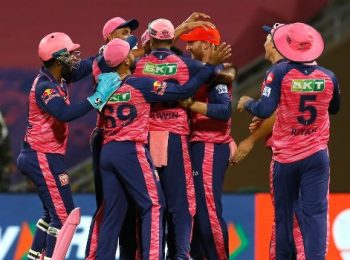To counter Bazball and then beat it, something special was needed by the Indian cricket team in the second Test match in Visakhapatnam. They found it from two players with stand-out, match-winning contributions to beat England by 106 runs inside four days to level the series 1-1 with three to go.
First, credit is due to the curator and ground staff in Visakhapatnam for rolling out a proper sporting surface that held up for four days, and on which there were runs on offer as well as enough for pacers and spinners on both sides. The first double-hundred by an Indian batsman at home – and just the second overall – since 2019 was scored by Yashaswi Jaiswal, there were nine wickets to Jasprit Bumrah including a match-changing six in one day, and the spinners claimed 23 wickets. This Test match, following on the heels of Hyderabad, showed that India do not need to rely on square turners all the time and it also cleared up any doubts over what kind of surfaces will be seen in Rajkot, Ranchi and Dharamsala.
Bumrah’s brilliance was to the fore when England batted the first time. His reverse-swinging skills accounted for a slew of batsmen, none more strikingly than Ollie Pope. In a throwback dismissal harking to the days of Waqar Younis and Wasim Akram, Bumrah sent down a deliciously curving yorker that sent Pope’s stumps cartwheeling. The batsman who had dented India with a brilliant 196 in Hyderabad was left completely befuddled, his bat lying on the pitch as he looked back to see his middle and leg stumps splayed.
And not long before that corker, Bumrah had sent back Joe Root after properly working him over. Seeing Mukesh Kumar start to move the ball late, Rohit Sharma summoned back his strike bowler. Immediately, Root was starting to second guess the movement of the ball and tentatively get his front pad out. In quick time Bumrah set him up with inswingers before the sucker ball – the one that went away – sent a furious Root on his way. Bumrah ended the innings with 6/45, his second five-wicket haul in just his sixth Test match in India.
On day four, Bumrah came back into the attack shortly before lunch and pinged Jonny Bairstow on the back leg to leave England 194/6 at the interval, still needing 205 more to win. Later in the day, when Ben Foakes and Tom Hartley were providing some resistance down the order – the highest stand of England’s second innings – it was Bumrah who dismissed them both for 36. Fittingly, he ended the match with the wicket of Hartley with a reverse-swinging delivery that took out off stump.
To think that on a surface such as this, the differentiator was an Indian pace bowler. Bumrah has been celebrated, but the time has come to place him in a different level when it comes to Test matches in India. During his match haul of 9/91 from 33.1 overs, Bumrah became the second-fastest Asian pacer to cross 150 Test wickets, doing so in 34 matches. And his bowling average of 20.19 per wicket stands as the second best of all time, in a sport dating back to 1877.
Bumrah was deservedly adjudicated the Player of the Match for nine wickets, but young opener Jaiswal can rightfully put his hand up and say ‘excuse me’. The 22-year-old, playing his second Test match at home, scored 209 out of India’s first innings of 396 while almost single-handedly setting the stage for the team’s resurgence. In a first innings in which the next best score was 34, Jaiswal was a beast. His double-century, peppered with 19 fours and seven sixes, was the batting differentiator in this match, make no mistake.
Shubman Gill’s second-innings hundred in came after 13 innings without a fifty. Before that 104, his last 12 innings were 34, 0, 23, 10, 36, 26, 2, 29*, 10, 6, 18 and 13. Gill admitted after his century on day three that he was nervous, going to the extent of saying that his heartbeat was the same from the first ball he faced until his last. So you can imagine the pressure on the 24-year-old who has been seen for several years as the future of India’s batting, who had not scored a fifty in 13 Test innings before this last one.
But let’s not take away from the fact that other Indian batsmen will be ruing their missed opportunities. Rohit was out for 14 and 13 in this match to make it eight Test innings without a half-century, and his batting average at home since the start of 2022 has dropped to 32. Shreyas Iyer failed again, with his second-innings dismissal particularly shocking. With 30 minutes left before the lunch break, Iyer skipped out to Tom Hartley looking for six over mid-on and was excellently taken by a running Ben Stokes near long-off. This means that Iyer’s previous 12 Test innings are 29, 27, 13, 35, 4*, 0, 6, 31, 26, 0, 12 and 4.
KS Bharat might be a supremely skilled wicketkeeper, but a Test batting average of 20 underlines the problem in repeatedly playing him. His seven Tests to date have produced scores of 6, 17, 28, 41, 23, 5, 44, 3, 17, 23*, 6 and 8. To see Bharat demoted down to seven in the batting order during India’s second innings in Visakhapatnam, after he was picked as one of the top six, said it all.
Axar Patel’s batting adds depth, but his bowling is not exactly match-winning. Kuldeep Yadav, in his first Test at home in two years, played a big role on days two and three with the wickets of Ben Duckett, Ben Foakes and Rehan Ahmed and on the final day he dismissed the dangerous Zak Crawley on 73. Man to man, Kuldeep has more skill as a bowler than Axar, but the latter, being an allrounder, plays far more at home because of the collective failures of India’s top six. This will have to change, even if it reduces a batting option.
And, lastly, do India need Mukesh Kumar? Or even a second pacer, for that matter? In the last two years, India’s second pacers after Bumrah have hardly been called on to bowl in the second innings – Mohammed Siraj played three Tests against Australia last year and sent down just one over in three of the visiting team’s second innings – and in this series, a total of 12 overs have been bowled by Siraj and Mukesh when England have batted a second time.
Yes, Bumrah’s workload must be managed, and it is unlikely that the 30-year-old will play all five Test matches. But given Rohit’s reluctance since becoming captain to use a second pacer as a home Test match progresses, as well as the success that India’s spinners have had, there is reason to thinking that it would be more beneficial in playing another batsman or allrounder instead.
Eight days between this and the next Test should offer the team management plenty of room to mull over the very evident fault lines, despite a very good win over England.



























